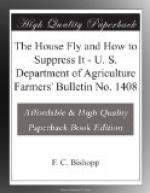Of the numerous substances tried, the one which seems best to fulfill these conditions is powdered hellebore.[10] For the treatment of manure a water extract of the hellebore is prepared by adding 1/2 pound of the powder to every 10 gallons of water, and after stirring it is allowed to stand 24 hours. The mixture thus prepared is sprinkled over the manure at the rate of 10 gallons to every 8 bushels (10 cubic feet) of manure. From the result of 12 experiments with manure piles treated under natural conditions it appears that such treatment results in the destruction of from 88 to 99 per cent of the fly larvae.
Studies of treated manure indicated that its composition and rotting were not interfered with. Furthermore, several field tests showed that there was no apparent injury to growing crops when fertilized with treated manure.
Since the solution is somewhat poisonous it should not be left exposed where it might be drunk by livestock. It is quite safe to say that chickens will not be injured by pecking at hellebore-treated manure. This has been tested carefully. Hellebore can be obtained both in ground and powdered form, but the powder gives the best results in the destruction of fly larvae.
[Footnote 10: Veratrum viride or V. aloum.]
TREATMENT WITH POWDERED BORAX.
Another chemical found to be even more effective as a larvicide is powdered borax. This substance is available in commercial form in all parts of the country. It has the advantage of being comparatively nonpoisonous and noninflammable and is easily transported and handled. The minimum amount necessary to kill fly larvae was found to be 0.62 pound per 8 bushels of manure, or about 1 pound per 16 cubic feet. Best results were obtained when the borax was applied in solution, or when water was sprinkled on after the borax had been scattered evenly over the pile. Borax is not only effective in killing the larvae, but when it comes in contact with the eggs it prevents them from hatching. When applied at the rate of 1 pound to 16 cubic feet it was found to kill about 90 per cent of the larvae, heavier applications killing from 98 to 99 per cent.
Borax has no injurious effect on the chemical composition or rotting of the manure. However, when added in large quantities with manure to the soil it will cause considerable injury to growing plants. A number of experiments have been conducted to determine the effect on crops of the use of manure treated with borax as herein recommended. When applied at the rate of 15 tons per acre it appears that no injury as a rule will follow. Some crops are more sensitive to borax than others, and also the tendency to injury appears to vary on different soils. It is necessary, therefore, to repeat the warning issued in connection with a previous bulletin[11] on this subject, that great care be exercised, in the application of borax, that the manure does not receive more than 1 pound for every 16 cubic feet, and that not more than 15 tons of manure so treated are applied to the acre.




